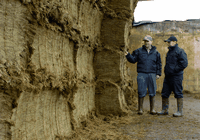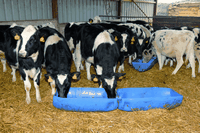Finding effective ways to mimimise farm waste

Disposing of farm waste, whether it is silage wrap, chemical containers or feed sacks, is no longer as simple as heaping it up and lighting a match.
In simple terms, that means it now costs more to dispose of waste. Logically, therefore, minimising the amount of waste produced will save money as well as helping the environment.
With that in mind, waste management expert David Baldwin, who is working with ADAS on the DEFRA-funded Environment Sensitive Farming project, walked around a Shropshire dairy farm to explore what can be done to reduce waste.
James Bourne of JS Bourne & Sons, Market Drayton, Shropshire, has looked at how to reduce the waste produced in his business, which is built around 220 milking cows and followers. He was keen to see whether Mr Baldwin could spot other practical ways to minimise waste further.
Waste minimisation
Before setting off, Mr Baldwin explained that waste minimisation was a management tool used in other industries outside farming. “Good waste managers set out in order of preference to avoid, reduce, reuse or recycle waste, rather than accumulating it and disposing of it,” he said.
“Think of it as resource management. By preventing resources from becoming waste we score a double whammy – reduced wastage and minimised disposal expense.”
For dairy cattle, silage and concentrates can be as much as 70% of production costs, so Mr Baldwin started with these. He was impressed with the tidiness of the silage clamp. Mr Bourne’s staff use a block cutter, so spoilage and wastage are avoided. This system is less wasteful than clamp-fed systems, where cows pull down silage and often trample it underfoot.
The feed bin was in good order, too, so no losses there. But in discussion Mr Bourne admitted that a part bin had been wasted recently and agreed that he needed to watch over-ordering.
Also good, was the minimised use of plastics on the clamp. “According to DEFRA’s booklet Saving Money by Reducing Waste, clamp silage uses about 0.16kg of plastic sheet per tonne of silage, whereas wrapped baled silage uses at least 1.3kg/t,” said Mr Baldwin.

Less contaminated
“The old sheet can be reused as an extra protective layer and any that is sent for recycling will generally be less contaminated with soil, slurry, silage and waste water than discarded bale wraps, where contamination can double the weight going for recycling.”
Mr Bourne does not recycle his plastics, so he was interested to hear that the Shropshire and Staffordshire Machinery Ring (SASTAK) operates a free-to-members recycling scheme for farm plastics. The scheme includes silage plastic, washed-out pesticide containers, feed buckets and any other types of plastic, including fertiliser and seed bags.
Mr Baldwin also pointed out that tyres and other debris must be kept out of the plastic when it is to be recycled.
For chemical containers, Mr Bourne has reduced pesticide usage over the past few years and no longer has a chemical store. “Not only are we more selective and critical in the use of chemicals, but we are finding that a targeted and just-in-time approach, using a specialist contractor, has saved us storage and application costs.

Installations
“As for the dairy, we have reduced dairy chemical use by installing sensors and monitors on the line wash and have gone for reuse of plastic by switching to 1000-litre IBCs, thereby avoiding disposal. We prevent luxuriant over-use by decanting into standard drums, so we can monitor and check hypochlorite usage,” he added.
Continuing the farm walk, Mr Baldwin spotted some broken and missing roof guttering. While Mr Bourne admitted that too much roof water entered the slurry system, he said this made the slurry easier to pump and meant an umbilical pipe and spreader system could be used.
Studies have shown better ammonia nitrate use with dilute slurry applications leading to faster grass recovery. Compared with heavy tankers, work rates are faster, reducing the cost per cubic metre of slurry applied, and ground damage is avoided. Soils are tested regularly and for the low PK index land, the recycled slurry reduces the bagged fertiliser requirement and cost.
Various other aspects were checked off and discussed during the review. For example, Mr Baldwin said waste minimisation could also lead to significant utilities savings. In the dairy, the DEFRA waste minimisation booklet advises that the pre-cooling of milk can reduce energy use by 50%.
Showing off his bulk tank ice monitors and economisers Mr Bourne was quick to point to his use of 5C borehole water for milk pre-cooling via a heat exchanger. “The warmed water is then used in the water heater and cattle drinking troughs,” he said.
And lastly, Mr Bourne said he used an agricultural engineer to do all tractor and equipment servicing and believed the cost was worth it, avoiding downtime and breakages. “Oil disposal is not an issue for us, as the engineer links into oil, tyre and battery recyclers. He is effectively taking care of those aspects on our behalf,” he said.
Avoid: Can this waste be avoided,can it be done another way? Reduce: Can the waste be cut down or reduced in some way? Are resources becoming waste too quickly? Can it be kept clean Reuse: Can plastic sheets or containers be reused, eg 1000-litre IBCs Recycle: Some waste materials have a value, check out the new recycling schemes, especially for plastic sheets etc Contact: for your nearest recycler, go to:
Related Links:
- Marks and Spencer to source more local food in drive to be greenest retailer
- Norfolk farmers asked to enter farm waste competition
- New waste regulations will mean a disposal licence increase
